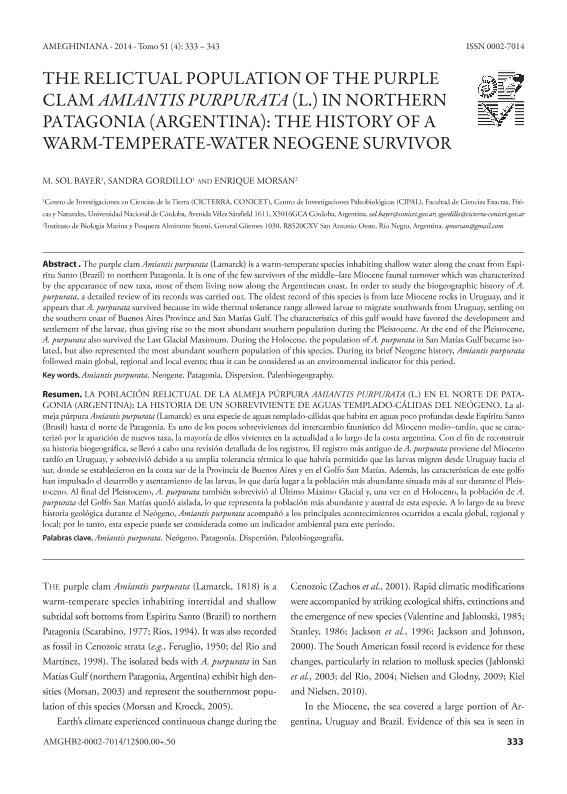Mostrar el registro sencillo del ítem
dc.contributor.author
Bayer, María Sol

dc.contributor.author
Gordillo, Sandra

dc.contributor.author
Morsán, Enrique
dc.date.available
2016-12-14T17:17:08Z
dc.date.issued
2014-06
dc.identifier.citation
Bayer, María Sol; Gordillo, Sandra; Morsán, Enrique ; The relictual population of the purple clam Amiantis Purpurata (l.) in northern Patagonia (Argentina): the history of a warm-temperate-water neogene survivor; Asociacion Paleontologica Argentina; Ameghiniana; 51; 4; 6-2014; 333-343
dc.identifier.issn
0002-7014
dc.identifier.uri
http://hdl.handle.net/11336/9381
dc.description.abstract
The purple clam Amiantis purpurata (Lamarck) is a warm-temperate species inhabiting shallow water along the coast from Espiritu Santo (Brazil) to northern Patagonia. It is one of the few survivors of the middle–late Miocene faunal turnover which was characterized by the appearance of new taxa, most of them living now along the Argentinean coast. In order to study the biogeographic history of A. purpurata, a detailed review of its records was carried out. The oldest record of this species is from late Miocene rocks in Uruguay, and it appears that A. purpurata survived because its wide thermal tolerance range allowed larvae to migrate southwards from Uruguay, settling on the southern coast of Buenos Aires Province and San Matías Gulf. The characteristics of this gulf would have favored the development and settlement of the larvae, thus giving rise to the most abundant southern population during the Pleistocene. At the end of the Pleistocene, A. purpurata also survived the Last Glacial Maximum. During the Holocene, the population of A. purpurata in San Matías Gulf became isolated, but also represented the most abundant southern population of this species. During its brief Neogene history, Amiantis purpurata followed main global, regional and local events; thus it can be considered as an environmental indicator for this period.
dc.description.abstract
La almeja púrpura Amiantis purpurata (Lamarck) es una especie de aguas templado-cálidas que habita en aguas poco profundas desde Espíritu Santo (Brasil) hasta el norte de Patagonia. Es uno de los pocos sobrevivientes del intercambio faunístico del Mioceno medio–tardío, que se caracterizó por la aparición de nuevos taxa, la mayoría de ellos vivientes en la actualidad a lo largo de la costa argentina. Con el fin de reconstruir su historia biogeográfica, se llevó a cabo una revisión detallada de los registros. El registro más antiguo de A. purpurata proviene del Mioceno tardío en Uruguay, y sobrevivió debido a su amplia tolerancia térmica lo que habría permitido que las larvas migren desde Uruguay hacia el sur, donde se establecieron en la costa sur de la Provincia de Buenos Aires y en el Golfo San Matías. Además, las características de este golfo han impulsado el desarrollo y asentamiento de las larvas, lo que daría lugar a la población más abundante situada más al sur durante el Pleistoceno. Al final del Pleistoceno, A. purpurata también sobrevivió al Último Máximo Glacial y, una vez en el Holoceno, la población de A. purpurata del Golfo San Matías quedó aislada, lo que representa la población más abundante y austral de esta especie. A lo largo de su breve historia geológica durante el Neógeno, Amiantis purpurata acompañó a los principales acontecimientos ocurridos a escala global, regional y local; por lo tanto, esta especie puede ser considerada como un indicador ambiental para este período.
dc.format
application/pdf
dc.language.iso
eng
dc.publisher
Asociacion Paleontologica Argentina

dc.rights
info:eu-repo/semantics/openAccess
dc.rights.uri
https://creativecommons.org/licenses/by-nc-sa/2.5/ar/
dc.subject
Amiantis Purpurata
dc.subject
Neogene
dc.subject
Patagonia
dc.subject
Dispersion
dc.subject
Paleobiogeography
dc.subject.classification
Paleontología

dc.subject.classification
Ciencias de la Tierra y relacionadas con el Medio Ambiente

dc.subject.classification
CIENCIAS NATURALES Y EXACTAS

dc.title
The relictual population of the purple clam Amiantis Purpurata (l.) in northern Patagonia (Argentina): the history of a warm-temperate-water neogene survivor
dc.type
info:eu-repo/semantics/article
dc.type
info:ar-repo/semantics/artículo
dc.type
info:eu-repo/semantics/publishedVersion
dc.date.updated
2016-12-12T20:58:15Z
dc.identifier.eissn
1851-8044
dc.journal.volume
51
dc.journal.number
4
dc.journal.pagination
333-343
dc.journal.pais
Argentina

dc.journal.ciudad
Buenos Aires
dc.description.fil
Fil: Bayer, María Sol. Consejo Nacional de Investigaciones Científicas y Técnicas. Centro Científico Tecnológico Córdoba. Centro de Investigaciones en Ciencias de la Tierra; Argentina
dc.description.fil
Fil: Gordillo, Sandra. Consejo Nacional de Investigaciones Científicas y Técnicas. Centro Científico Tecnológico Córdoba. Centro de Investigaciones En Ciencias de la Tierra; Argentina
dc.description.fil
Fil: Morsán, Enrique . Instituto de Biología Marina y Pesquera Almirante Storni; Argentina
dc.journal.title
Ameghiniana

dc.relation.alternativeid
info:eu-repo/semantics/altIdentifier/doi/http://dx.doi.org/10.5710/AMGH.12.05.2014.2741
Archivos asociados
